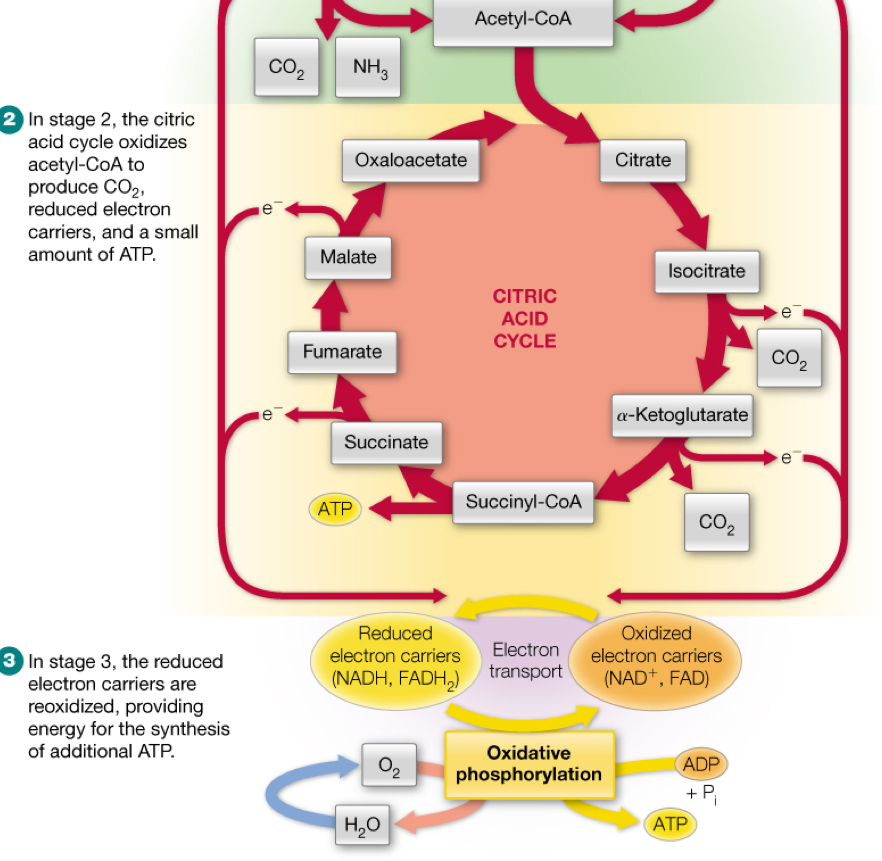
LEARNING OUTCOMES
After completing the course, the student is able to:
- Explain the differences between anabolic and catabolic pathways
- Understand the basic thermodynamics relevant for metabolism (bioenergetics)
- Explain how ATP is produced from the oxidation of carbohydrates and fatty acids; and calculate how much ATP is produced
- Name all intermediates of glycolysis and draw their structural formulas
- Name all intermediates of the citric acid cycle and draw their structural formulas
- Explain the differences between glycolysis and gluconeogenesis, and why these differences are needed
- Explain the differences between the oxidative and the reductive citric acid cycle, and why these differences are needed
- Explain the differences between fatty acid degradation and synthesis, and why these differences are needed
- Explain how the electron transport chain works
- Name different CO2-fixation pathway and describe their differences
- Explain the function of different electron carriers in terms of their use and redox potential
- Identify redox reactions and calculate oxidation numbers
- Understand the importance of metabolism for biology and biotechnology
- Learn independently and manage time
- Integrate and evaluate information from a variety of sources
Credits: 5
Schedule: 04.09.2023 - 20.10.2023
Teacher in charge (valid for whole curriculum period):
Teacher in charge (applies in this implementation): Silvan Scheller
Contact information for the course (applies in this implementation):
CEFR level (valid for whole curriculum period):
Language of instruction and studies (applies in this implementation):
Teaching language: English. Languages of study attainment: English
CONTENT, ASSESSMENT AND WORKLOAD
Content
valid for whole curriculum period:
The focus is metabolism on a fundamental level relevant to all forms of life, with emphasis on the chemistry of intermediates. Careful look at the balance of atoms, electrons (redox state) and energy during metabolic pathways.
One part is the aerobic energy metabolism (catabolism): glycolysis, citric acid cycle, electron transport and oxidative phosphorylation, degradation of lipids, amino acids, nucleotides. Selected anabolic pathways ("reverse direction") will be discussed: gluconeogenesis, fatty acid synthesis, amino acid synthesis.
A second part is the anaerobic metabolism, with a focus on CO2 fixation. Calvin cycle, reverse citric acid cycle, introduction to all known CO2-fixation pathways. Bioenergetics. Energy conservation in methanogens and acetogens. Utilization of hydrogen as an electron source. Concept of electron bifurcation.
Applications of metabolic pathways for the production of value-added products from CO2 or from biomass-derived feedstocks. Introduction to metabolic engineering.
Assessment Methods and Criteria
valid for whole curriculum period:
Online exercises
Learning diaries
Exam (written and/or oral), updated information follows in MyCourses
Workload
valid for whole curriculum period:
Lectures
Online exercises
Learning diaries
DETAILS
Substitutes for Courses
valid for whole curriculum period:
Prerequisites
valid for whole curriculum period:
SDG: Sustainable Development Goals
4 Quality Education
7 Affordable and Clean Energy
12 Responsible Production and Consumption
13 Climate Action
FURTHER INFORMATION
Further Information
valid for whole curriculum period:
Teaching Language : English
Teaching Period : 2022-2023 Autumn I
2023-2024 Autumn IA course implementation may be cancelled if the number of students enrolled to the course implementation does not meet the required minimum of five students. In the case of cancelled course implementations, the students enrolled to them must be provided with an alternative way of completing the course or be advised to take some other applicable course.
